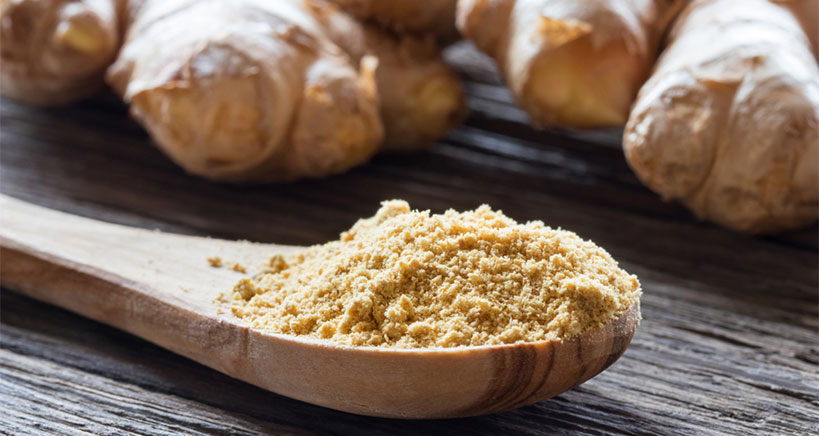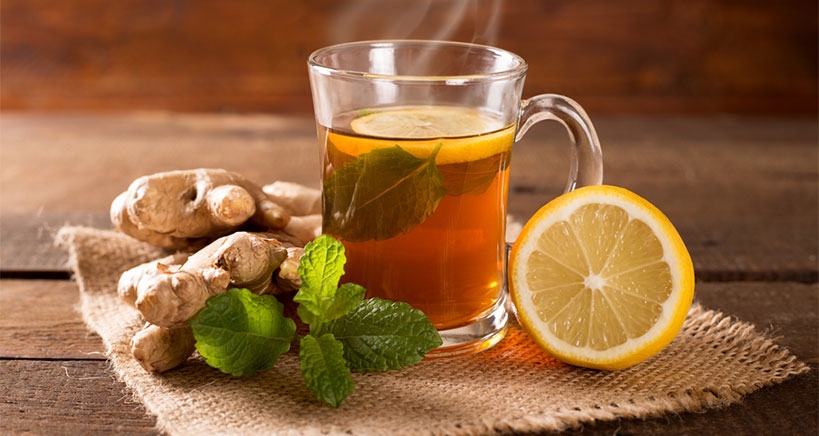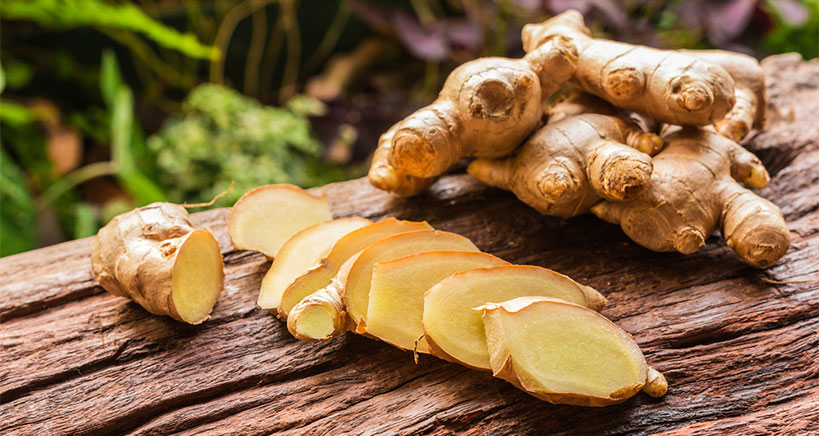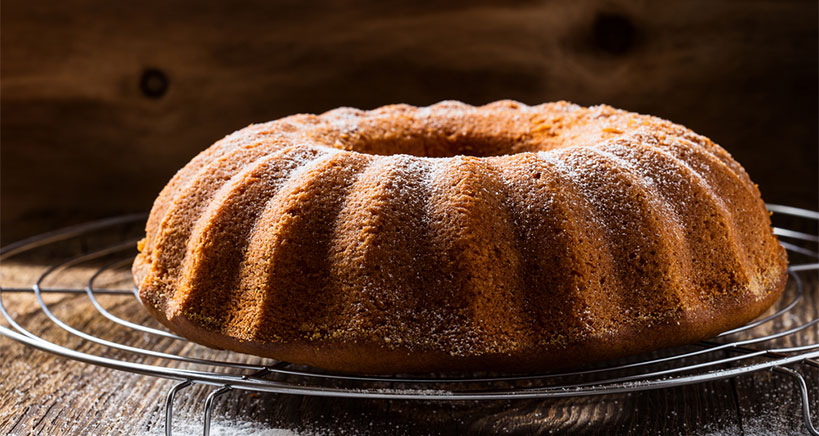
Welcome to the Wonderful World of Ginger! In both its raw and powdered forms, ginger has been named a ‘superfood,’ and for good reason. Well-known for its usage as a savory spice and as a medicinal plant, ginger is not only one of today’s top herbs for cooking and baking, it has also played a prominent role in Chinese medicine and Ayurveda nutrition for over 3,000 years where it hailed as both a potent anti-inflammatory and flavor enhancer.
From its origins as one the first spices exported to Europe from the Orient during the spice trade, and up until today, where ginger’s sharp, pungent taste and aroma is a star ingredient in many main course and dessert recipes – there are countless reasons why ginger should be at your chefs’ fingertips and why ginger recipes should feature prominently on your restaurant menu.
Ginger Quick Facts
Although the ginger plant has been around for millennium, its plethora of benefits continue to astound, so let’s indulge our taste buds with some juicy ginger facts.
- The ginger plant is an herb belonging to the Zingiberaceae family, which includes turmeric and cardamom
- Ginger’s root, aka rhizome, is used prolifically in recipes, and the flesh of its root can be yellow, white, or red and made into a powder
- Ginger rhizomes can be steeped in boiling water to make ginger tea or be made into ginger wine or candy
- Ginger is also available as ginger oil, ginger extract, and in tinctures, capsules, and lozenges
- Some popular ways ginger is used in recipes includes flavoring curry dishes and sauces, stewed with other spices, simmered into syrups, spicing breads and baked goods, as well as making digestive tonics such as ginger ale and ginger beer
Ginger History
Long before the advent of gingerbread houses and ginger snap cookies, ginger was used prolifically as the ‘Pepto-Bismol’ of its time – that is, to quell upset stomachs. It first made its way from Asia to Europe along the famous Silk Road, the ancient trade route linking China with the West. The Romans were the first to use it to enhance the taste of preserved meats, as well as a digestive aid, and it wasn’t long before other cooks took notice and began incorporating ginger in cooking and baking recipes, where it was often mixed with other spices such as cinnamon or sweetened with honey.
Next, ginger’s flavorful appeal spread to the Greeks, who were famous for their early version of gingerbread and for the “gingerbread fairs” that were held in medieval Europe around 2400 B.C. The history books tell us that it was also around this time that “gingerbread men” were formed in Elizabethan England, and that Queen Elizabeth I herself instructed her kitchen staff to create whimsical gingerbread men decorated with candies and gold leaf in the shapes of visiting dignitaries and diplomats.

By the year 1812, German bakers began constructing elaborate gingerbread houses akin to the candy-studded gingerbread house featured, in the soon-to-become famous, Brothers Grimm’s publication of Hansel and Gretel.
Finally, arriving to the New World during the time of the colonists, ginger’s popularity began to grow among American bakers and consumers alike. Since then, the flavor and aroma of ginger continues to manifest in various ways. While often featured in baked goods in the Western world, in Asia the ingredient is largely used to add zest to seafood, meat, and vegetarian dishes. Ginger is a staple in Indian curries, a mainstay in Japan served alongside sushi or shredded into soups, while in Jamaica ginger beer takes the top spot. With a pedigree that dates back millennium and still popular today, it is safe to say in the culinary world, ginger is second to none!
Ginger Health Benefits
The age-old Indian proverb says it all: “Everything good is found in ginger”! This wonder spice has also been called the “great universal medicine” by Ayurvedic practitioners, while traditional Chinese medicine maintains that ginger “expels cold” and “restores devastated yang.” Here are some the reasons why ginger is not only one of the oldest medicinal foods but one of the most beneficial:
- Contains an impressive array of important vitamins and minerals, including ginger’s claim to fame, gingerol, a compound with potent anti-inflammatory and antioxidant properties
- Anti-Bacterial: The gingerol in fresh ginger helps destroy oral pathogens and bacteria that causes stomach ulcers
- Nausea Relief: Ginger is known to reduce nausea related to pregnancy/morning sickness, motion/sea sickness, and surgery
- Cold/Flu Relief: Not only is drinking ginger tea a great way to stay warm in the winter, but the herb is well-loved as a soothing natural remedy for colds or the flu. To make ginger tea at home, steep some sliced fresh ginger in hot water; add honey or a slice of lemon for additional flavor
- Muscle Pain Reduction: Ginger effectively reduces exercise-induced muscle soreness and pain; studies also indicate that ginger can alleviate symptoms of osteoarthritis
- Blood Sugar Reduction: Multiple studies indicate that consuming ginger helps lower blood sugar levels and may decrease risk of heart disease for people with Type 2 diabetes
- Constipation Prevention/Chronic Indigestion Treatment: The phenolic compounds in ginger help relieve gastrointestinal irritation by stimulating saliva and bile production and by suppressing gastric contractions that lead to constipation and/or indigestion. These same properties may help prevent colon cancer
- Menstrual Pain Reduction: Likewise, ingesting ginger at the beginning of the menstrual period effectively reduces related discomfort
- Cholesterol Reduction: There is evidence that ginger helps lower LDL (bad) cholesterol and blood triglyceride levels, thereby improving cardiovascular health

How to Include Ginger in Recipes
Whether you are using fresh ginger or its dried and powdered version, there are endless ways to include and enjoy ginger in recipes: It can be minced or sliced and cooked in sugar to create a candied or crystallized version. It pairs well with fish, chicken, seafood, rhubarb, pumpkin, squash, melon, apples, and oranges. It adds flavor to stir-fries and homemade salad dressings. It is popularly sprinkled on hot breakfast cereals or rice porridges. And since ginger’s flavor simply melts into baked goods, it is a top ingredient in the preparation of muffins, breads, and classic favorites such as carrot cake, Christmas cookies, banana bread, pumpkin pie, and of course ginger snaps.
In international cuisine, ginger is a frequent accompaniment to sushi and is a featured ingredient in the classic Indian chickpea dishes chana masala and chicken tikka masala. Elsewhere, slices of ginger are served between courses to clear the palate.
Keep in mind that in most recipes, you can substitute one tablespoon of fresh grated ginger with one-eighth of a teaspoon of ground ginger. Conversely, for recipes that call for dried ground ginger, replace with half the amount of fresh ginger (i.e. for 2 tsp. ground ginger, use 1 tsp. of grated fresh ginger).
Finally, you can store dried ginger powder in a sealed jar in the fridge for up to one year. Fresh ginger can be stored in the fridge or freezer in a tightly wrapped plastic bag.
Ginger Beverages
Versatile ginger also makes some delish beverages! In addition to ginger ales, beers, and tea, try your chef’s hand at making a ginger syrup for spritzers. Here’s how:
In a saucepan, mix 1 cup of water with 3/4 cup sugar. Cook on medium-high heat until the sugar dissolves. Turn off stove, add 1 cup of sliced ginger, cover, and allow the ginger syrup to infuse overnight. Finally, strain ginger slices and pour 1/4 cup of the ginger syrup into a serving glass. Fill the glass with seltzer water, stir gently, and voila! The perfect ginger spritzer! (Yield: 8 drinks)

Lemon Ginger Cake Recipe
If this Guide to Ginger has stimulated your appetite, you are in for a treat. Bon Appetit and enjoy sharing the following recipe with your customers!
Ingredients
- 1-1/2 cups flour
- 1 tsp. baking powder
- 1/4 tsp. ground ginger
- 1/4 tsp. salt
- 1/2 cup milk
- 1/2 tsp. vanilla
- 2 tbsp. freshly squeezed lemon juice
- 3/4 cup plus 2 tbsp. sugar
- 1 tbsp. grated lemon
- 2 tbsp. freshly grated (peeled) ginger
- 1/2 cup unsalted butter at room temperature
- 2 eggs
Syrup
- 1/4 cup sugar
- 2 tsp. freshly squeezed lemon juice
- 2 tsp. water
- Instructions
- Heat oven to 320F/160C.
- In one bowl, sift together flour, baking powder, ground ginger, and salt. In another bowl, combine milk, vanilla extract, and lemon juice.
- In another small bowl, run sugar, lemon zest, and grated ginger through a food processor or use your fingers to combine well.
- In a mixing bowl and using a mixer, beat butter and lemon-sugar mixture until light and fluffy. Add eggs one at a time, beating well after each addition. On low speed, beat in half the flour mixture, then the milk mixture, and finally the remaining flour mixture.
- Pour batter into an 8-1/2” x 4-1/4” loaf pan and bake for approximately 45 minutes (until an inserted toothpick comes out clean). Cool for 10 minutes before adding syrup.
- SYRUP: Prepare syrup by combining sugar, lemon juice, and water in a small saucepan and cooking on medium-low heat until sugar dissolves and syrup forms. Cool.
- While cake is still warm, brush with syrup. Allow cake to cool completely before cutting as the warm syrup makes it extra moist and it may crumble.
- Serve and enjoy!